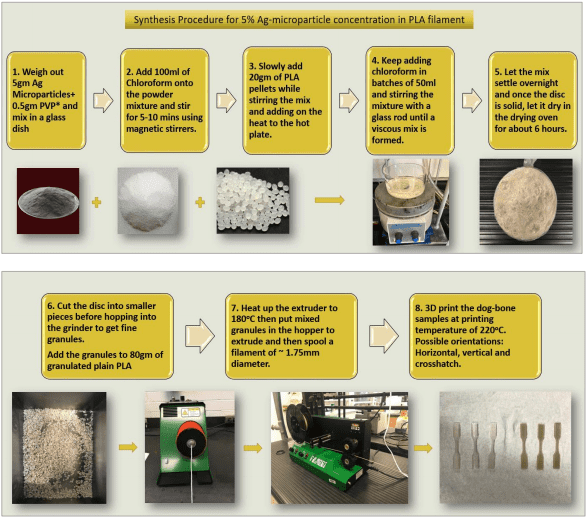
[ihc-hide-content ihc_mb_type=”show” ihc_mb_who=”reg” ihc_mb_template=”3″ ]
[vc_row][vc_column][vc_column_text]
These materials are potentially very useful because of their antimicrobial, electrical, mechanical and optical properties. They are of special interest to the food industry, Shrestha points out, because of microbes in the polymer belts that are used to transfer and package food items, particularly meat items, in factories. If polymer belts with antimicrobial properties could be developed, it could have a major impact on the industry.
She then used the filament to 3D print several disks, onto which she dripped an E. coli solution. She also added the bacterial solution to plain PLA disks. After 24 hours, the silver composite disks showed dramatically fewer bacteria than the plain PLA disks.
“Although a linear trend or correlation has not been yet developed between the varying weight percentage of the silver and the effect on the ductility, thermal, and anti-microbial properties,” Shrestha states. “This is mainly because of the challenges in evenly distributing the silver microparticles in the PLA matrix, which can be attributed to several factors such as high viscosity of PLA, tendency of silver particles to accumulate together, and incompatibility of chloroform with other plastic container. Due to the uneven distribution during the synthesis process, a certain part of 1% silver filament might have more concentration of silver particles as compared to a certain part of 3% silver filament. Due to these uncertainties a clear conclusion cannot be drawn on the effect of a certain silver weight percentage on the enhancement of various mechanical, thermal, and anti-microbial properties.”[/vc_column_text][/vc_column][/vc_row][vc_row][vc_column width=”2/3″][vc_column_text]Future work, she continues, will be geared towards optimizing the process and obtaining more data points to draw conclusive results. Possible further work may include:
Shrestha’s study is very promising for not just the food industry but several others, including the medical industry. The ability to 3D print surgical tools with antimicrobial properties is always of interest, and silver is a material that, as Shrestha points out, has not been very thoroughly studied in 3D printing, particularly when mixed with polymers. While still in the preliminary stages, her study could potentially have an impact on the creation of new 3D printing materials with highly useful properties.
Source: 3dprint.com
Building on their established successes in India and the USA, EOS and Phillips Machine Tools…
CPAC, a subsidiary of SCG, has entered into a significant partnership with SAMSUNG E&A to…
A research team from Graz University of Technology (TU Graz) in Austria has introduced two…
Aircraft maintenance plays a critical role in today's aviation industry, especially given the current challenges…
Calum Stewart Calum Stewart, a leading figure at SPEE3D, has been at the forefront of…
The Vice President of Rolf Mack at KraussMaffei talks about the future vision of Additive…
This website uses cookies.